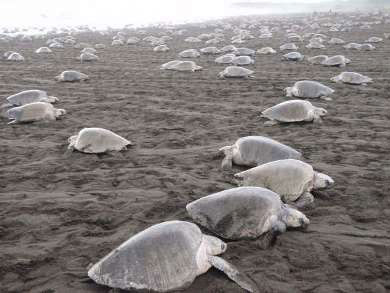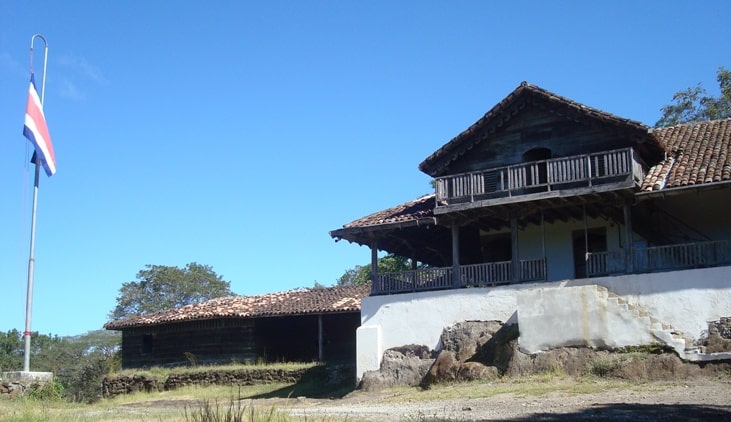One of the best things about living near Tamarindo is the sheer variety of things to do. And, while the beaches and the surf get much of the glory, the truth is that there are so many other sights and sites to explore. Today, we thought we’d introduce you to Part 1 of our series on Educational Day Trips from CRIA, beginning with five Guanacaste national parks and wildlife refuges.
For each day trip, we’ve given you a jumping-off point: an overview of the park, why it made our list, some fun facts, and additional resources. But really, these parks are so vast and wondrous, they have many lessons to teach and new experiences to usher into your family’s life. Enjoy!
For Volcanology & Geothermal Science: Rincón de la Vieja National Park
Distance from CRIA: 72.7 miles / 117 kms
Fun Fact: Volcanology, which is sometimes spelled vulcanology, has nothing to do with Star Trek, a bit to do with ancient Rome, and everything to do with volcanoes. The word is derived from the Latin word vulcan, for Vulcan, the ancient Roman god of fire. It’s an appropriate etymological root for the study of volcanoes, lava, and magma!
There is so much to love about Rincón de la Vieja National Park and its eponymous volcano. We’ll begin with some impressive statistics: This 35,336-acre national park is home to 32 rivers and streams, 300 bird species, primary tropical dry forest and cloud forest, and Rincón de la Vieja Volcano – an active behemoth comprised of 9 separate but contiguous craters, which together form the largest volcano (of 5) in the Guanacaste Mountain Range.
Clearly, there’s plenty to explore and learn about here. (It’s one of the most popular Guanacaste national parks for a reason!) And there’s no place better to do it than the Las Pailas Sector – RdlV National Park is divided into two distinct sectors; the other is Santa María, which offers an 8-hour round-trip hike to the volcano (when safety permits) – which promises exploration and jaw-dropping sights, including boiling mud pots (pailas, appropriately!), steaming fumaroles, hot springs (note: not for soaking!), volcanic craters, seasonal waterfalls, and more.
Additional Resources:
- SINAC: Rincón de la Vieja National Park (Spanish)
- NatGeo: 17 Explosive Volcano Facts
- Earth Science: Volcanic Landforms and Geothermic Activity
For Sea Turtle Conservation: Las Baulas National Marine Park & Ostional Wildlife Refuge
 Costa Rica is not only home to four sea turtle species – leatherbacks, olive ridleys, green, and hawksbill – but to incredibly important sea turtle nesting beaches. And that’s extra important, when you consider that many species will only nest on specific beaches – sometimes, the very beach where that turtle hatched! It’s no wonder that Costa Rica takes sea turtle and habitat conservation so seriously.
Costa Rica is not only home to four sea turtle species – leatherbacks, olive ridleys, green, and hawksbill – but to incredibly important sea turtle nesting beaches. And that’s extra important, when you consider that many species will only nest on specific beaches – sometimes, the very beach where that turtle hatched! It’s no wonder that Costa Rica takes sea turtle and habitat conservation so seriously.
Las Baulas National Marine Park:
Distance from CRIA: 8 miles / 13 kms
Fun Fact: Leatherback sea turtles are the world’s largest sea turtle – and also one of the most unique! Not only can they measure 6 feet (2 meters) long and weigh up to 1,500 pounds (900 kgs), but these ocean giants are the only sea turtle species to swap a hard outer shell for one that’s soft (like leather) and flexible.
Did you know that there’s a national park practically at our front door? ‘Tis true! El Parque Nacional Marino Las Baulas, or Las Baulas (Leatherback) National Marine Park is the nearest of the Guanacaste national parks and occupies an impressive 43,240+ acres (175 km2) – but only about 1,900 acres (7.7 km2) are on land!
The balance belong to the Pacific: protected ocean waters that welcome nesting sea turtles every year. Indeed, this coastal park is one of the world’s largest leatherback turtle nesting sites, hosting hundreds of nesting mothers every year. And that’s incredibly important, when you consider that leatherbacks are an endangered species and their world populations are on the decline.
Notably, Las Baulas National Park is also home to another of Tamarindo’s ecological riches: the Tamarindo Estuary and its incredibly biodiverse (and biologically valuable) mangrove forests. Grab a kayak and go explore!
Ostional Wildlife Refuge:
Distance from CRIA: 43.4 miles / 69.8 kms
Fun Fact: Olive ridley sea turtles weigh 80-100 pounds as adults but, when born, weigh just 12 to 22 grams – about 3 to 4 of those sugar packets you find on restaurant tables!
If you want to go big on wow factor, you can’t go wrong at Ostional Wildlife Refuge (note: this is a national wildlife refuge, not technically one of our Guanacaste national parks). One of the world’s most important sites for nesting sea turtles, Ostional protects 1,150+ land acres and almost 20,000 marine acres – ocean wilds reserved for the olive ridley sea turtles that nest here.
And about that wow factor: Ostional Wildlife Refuge is the site of one of the natural world’s more spectacular events: arribadas, or mass sea turtle nestings. Every year, hundreds of thousands of olive ridley sea turtles (sometimes 10,000+ at one time!) come to these shores on coordinated arribadas throughout the year (peak season: June and December).
Another fun fact? Only olive ridley turtles and their close cousins, Kemp’s sea turtles (not present in Costa Rica), coordinate in these mass nesting events, which are truly spectacular to behold.
Additional Resources:
- SINAC: Las Baulas National Marine Park (Spanish)
- NatGeo Kids: Leatherback Turtle Facts
- NOAA: Olive Ridley Sea Turtles
For Subterranean Ecosystems & Cave Formations: Barra Honda National Park
Distance from CRIA: 42 miles / 67.6 kms
Fun Fact: While the terms “spelunking” and “caving” relate to exploring caves, speleology is the science of studying caves. Strangely, though, you can’t (yet) get a degree in speleology; universities don’t offer it as a major! Instead, you’ll want to focus on the core sciences (physics, chemistry, and biology) and pair them with geology, geography, cartography, and the biological sciences, with some pinch-hitting from anthropology and zoology.
If you didn’t know you could go cave spelunking in Costa Rica, then now you do! Perhaps one of Costa Rica’s still better-kept secrets (and one of the least touristed of the Guanacaste national parks), this incredible collection of caverns houses ancient coral reefs and soft limestone, long ago forced toward the surface by shifting tectonic plates; from there, rain and its best friend, erosion, took over, carving out Barra Honda’s subterranean caves and caverns, stalactites and stalagmites. (It took 70 million years but hey, we made it!)
Though the park was first created in 1971, to date, speleologists have studied not even half (19 of 42) of Barra Honda’s caves. Among the treasures unearthed: pre-Columbian artifacts, cavern wildlife, and striking cave formations – and scientists believe there’s much more still to come.
Note that you’ll probably want to book a cavern tour, in addition to your park entrance. It’s the best and safest way to explore Barra Honda’s famous trio: Terciopelo (Fer de Lance), Santa Ana, and Trap caverns. Tours typically have a minimum age of 10.
Additional Resources:
For Costa Rican Heritage & History: Santa Rosa National Park
File:HaciendaSantaRosa.jpg by Rodtico21 is marked with CC BY-SA 4.0
Distance from CRIA: 67 miles / 108 kms
Fun Fact: Before a “filibuster” became a delay tactic in legislature, it described the buccaneers who plundered Spanish and formerly Spanish lands in the New World. By the 1800s, the term had narrowed to refer to U.S. invaders who, without consent from the U.S. government (and in clear violation of the 1818 Neutrality Act), attempted to seize power in Latin America and the Caribbean. The then-new nation of Costa Rica once fought the filibusters!
There’s a lot to love about Santa Rosa National Park – rare tropical dry forest ecosystems, nesting sea turtles, and incredible biodiversity that extends to 4,000 butterfly species, 250 bird species, and 115 mammal species – but our recommendation is rooted in none of those. Surprise!
In fact, you’re here for Costa Rican history, at the site where would-have-been invaders were defeated and cast out from Costa Rica. Let’s rewind: In the mid-1800s, “filibusters” came to Costa Rica; led by American – although he would likely have deemed himself a Confederate, as these were Civil War times – William Walker, the filibusters drove into the Americas, in pursuit of control over the region.
During the Battle of Santa Rosa, on March 20, 1856, a small Costa Rican army – including national hero Juan Santamaría, a drummer boy who sacrificed himself to distract the foreign invaders – defeated Walker’s filibusters and drove them into Nicaragua. Their final fight took place a La Casona, a ranch house and now a national monument and small museum at Santa Rosa National Park.
Notably, Santa Rosa – undeniably, the most historic of our Guanacaste national parks – has witnessed two other battles against foreign invaders: One in 1919, when invaders tried to overthrow the government of Federico Tinoco Granados; and the second in 1966, when Costa Ricans drove out the Nicaraguan army and their leader Anastasio Somoza, whose burned-out tank still sits where the Nicaraguans fighters abandoned it.
Additional Resources:
- SINAC: Santa Rosa National Park (Spanish)
- History.com: William Walker and His Private Army
- What is a filibuster?
Inspire a Love of Learning at CRIA
Great parents want great things for their children. Help your children find their inspiration, their interests, and their passions at CRIA.
We don’t want you to just take our word for it, though. Come and visit. Tour our campus. Poke your head into one of our classes, a swim class, or an extracurricular. Get a feel for our community. See if it inspires you.
Whether you’re wondering about tuition & fees or special education in Costa Rica, cafeteria nutrition or the admissions process, we’re here to help. And when you’re ready to take the next step – to come, visit, and get your questions answered in person – we’d love to welcome you!
Get in touch to schedule a campus visit. We look forward to it!


